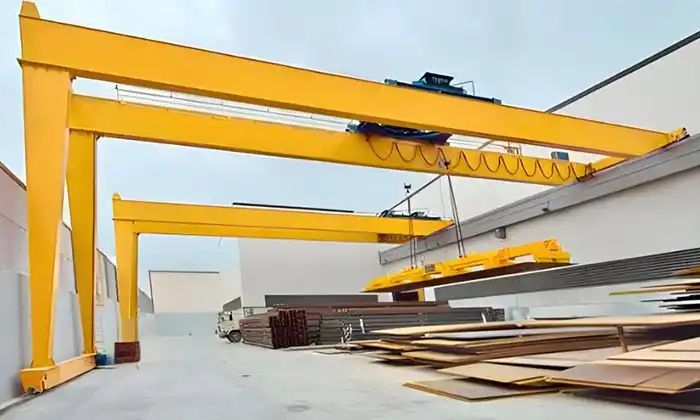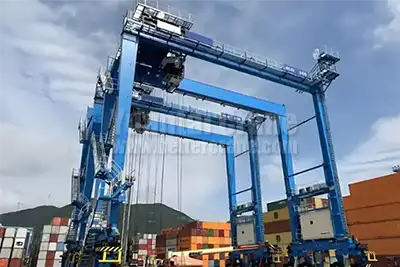High-Speed Machining Center Integration with Half Gantry Cranes
High-Speed Machining Center Integration with Half Gantry Cranes
High-speed machining centers represent cutting-edge technology in manufacturing, designed for precision and rapid production of complex parts. These centers utilize advanced tools and techniques to achieve high accuracy and speed in machining operations, making them crucial in industries requiring efficient production cycles and quality outputs.
Efficient material handling is pivotal in machining operations to ensure seamless workflow and optimized production processes. The integration of reliable material handling solutions, such as half gantry cranes, plays a critical role in supporting the operational demands of high-speed machining centers. These cranes facilitate the movement of heavy machining components and CNC machine tools with precision and efficiency, enhancing overall productivity and minimizing downtime. Thus, their incorporation is essential for maintaining the high standards of performance and reliability expected in modern machining environments.
BMH single girder Half gantry crane parameters:
- Load capacity: 3-20t
- Span: 8-30m
- Lifting height: 6-18m
- Lifting speed: 0.33-8m/min
- Trolley running speed: 20m/min
- Crane running speed: 20m/min
- Work duty: A3-A4
BMG double girder Half gantry crane parameters:
- Load capacity: 5-32t
- Span: 12-30m
- Lifting height: 6-12m
- Lifting speed: 6-11.5m/min
- Trolley running speed: 37-40.1m/min
- Crane running speed: 37.7-40.1m/min
- Work duty: A3-A6
Typical Loads Handled
Half gantry cranes are specifically engineered to handle a diverse range of heavy and sensitive loads essential in high-speed machining environments:
CNC Machine Tools:
These encompass a variety of precision equipment such as vertical machining centers (VMCs), horizontal machining centers (HMCs), and multi-axis CNC machines. These tools are crucial for performing intricate operations like cutting, milling, drilling, and shaping raw materials into finished components. Half gantry cranes play a vital role in the seamless and precise handling of CNC machine tools. They assist in their installation onto machining centers, facilitate maintenance tasks, and enable effortless repositioning within the facility. This capability ensures that machining operations remain uninterrupted and efficient, supporting continuous production cycles with minimal downtime.
Heavy Machining Components:
This category includes a wide array of robust components such as castings, forgings, molds, and structural parts utilized across diverse industries such as aerospace, automotive, and general manufacturing. These components are often large, bulky, and have substantial weight, requiring specialized lifting equipment like half gantry cranes for safe and efficient transportation. Half gantry cranes are equipped with robust structural frameworks and precision lifting mechanisms designed to manage the weight and dimensions of heavy machining components effectively. They facilitate the smooth movement of these components across the machining floor, from storage areas to machining centers or assembly stations. By ensuring secure handling and precise placement of heavy loads, half gantry cranes contribute significantly to reducing production bottlenecks and optimizing workflow efficiency in high-speed machining operations.
In summary, half gantry cranes are indispensable tools in high-speed machining environments due to their capability to handle a wide range of heavy and delicate loads with precision and efficiency. Their design features and operational capabilities make them essential for maintaining seamless production processes and enhancing overall productivity in modern manufacturing facilities.
Benefits of Half Gantry Cranes
Half gantry cranes offer several advantages that enhance the efficiency and cost-effectiveness of material handling in high-speed machining environments:
Improved Workflow Efficiency:- Precision Handling: Half gantry cranes facilitate precise positioning and movement of CNC machine tools and heavy machining components, ensuring efficient workflow management.
- Reduced Downtime: By minimizing the time required for material handling tasks, these cranes help optimize machining center operations and reduce downtime between production cycles.
- Enhanced Productivity: Efficient load handling and quick setup capabilities contribute to increased productivity and throughput in machining operations.
Cost-Effective Material Handling Solutions:
- Lower Operating Costs: Half gantry cranes typically have lower initial investment costs and reduced maintenance requirements compared to full gantry cranes, providing cost-effective solutions for material handling needs.
- Space Optimization: Their compact design and ability to operate in confined spaces optimize floor space utilization, allowing machining centers to allocate resources more efficiently.
- Flexible Deployment: These cranes offer flexibility in deployment configurations and can be customized to meet specific operational requirements, ensuring maximum cost-efficiency over their operational lifespan.
Incorporating half gantry cranes into high-speed machining centers not only enhances workflow efficiency by streamlining material handling processes but also contributes to cost savings through optimized resource utilization and reduced operational downtime. These benefits make them integral components in achieving high-performance standards in modern machining operations.
Integration Considerations
Effective integration of half gantry cranes into high-speed machining centers requires careful consideration of compatibility with machining center requirements and customization options tailored to specific machining applications:
Compatibility with High-Speed Machining Center Requirements:
- Precision and Accuracy: Half gantry cranes must align with the stringent precision and accuracy standards of high-speed machining centers. They should provide smooth and controlled movements to avoid vibrations or disturbances that could affect machining operations.
- Load Capacity and Handling: Ensuring that the crane's load capacity matches the weight and dimensions of the materials handled by the machining center is crucial. This compatibility guarantees safe and efficient material transfer without compromising operational efficiency.
- Space Utilization: Optimizing floor space within the machining center is essential. Half gantry cranes should be configured to fit seamlessly into existing layouts while allowing for unrestricted movement of materials and equipment.
Customization Options for Specific Machining Applications:
- Adaptability to Workpiece Sizes: Customizable features such as adjustable span widths and lifting heights enable half gantry cranes to accommodate varying sizes of workpieces and components used in different machining applications.
- Specialized Handling Requirements: Machining centers may require specialized handling capabilities for delicate or irregularly shaped materials. Customized crane attachments, such as vacuum lifters or magnetic grippers, can be integrated to ensure safe and precise handling of specific materials.
- Environmental Conditions: Consideration of environmental factors such as temperature, humidity, and cleanliness levels within the machining environment may necessitate the use of specialized coatings or materials for crane components to ensure long-term reliability and performance.
Integrating half gantry cranes into high-speed machining centers involves aligning their capabilities with the operational needs and constraints of the machining environment. Customization options play a critical role in optimizing crane performance and enhancing overall efficiency in machining operations. By addressing these integration considerations, manufacturers can maximize the benefits of half gantry cranes in supporting streamlined material handling processes and maintaining high standards of machining quality and productivity.
Case Studies
Exploring successful implementations of half gantry cranes reveals their significant impact on operational efficiency and productivity in high-speed machining environments:
Automotive ManufacturingIn an automotive manufacturing facility, a half gantry crane was integrated to handle large molds and tooling used in the production of vehicle components. By efficiently transporting these heavy components between machining stations and storage areas, the crane reduced material handling times by 30%. This improvement not only optimized workflow efficiency but also minimized downtime associated with production delays, resulting in increased overall productivity.
Aerospace Industry
A machining center specializing in aerospace components implemented a customized half gantry crane to maneuver intricate parts within a confined production area. The crane's precision lifting capabilities ensured accurate positioning of components during machining operations, enhancing machining accuracy by 15%. This level of precision contributed to a reduction in rework and scrap rates, thereby improving manufacturing yield and operational cost-effectiveness.
Impact on Operational Efficiency and Productivity
- Streamlined Material Flow: Half gantry cranes streamline the flow of materials and components within machining centers, reducing congestion and optimizing production workflows. This streamlined material handling process minimizes idle times and enhances overall operational efficiency.
- Reduced Downtime: Efficient handling of heavy and delicate components by half gantry cranes minimizes downtime associated with material transfer and setup. Machining centers experience fewer interruptions, allowing for continuous production cycles and maximizing machine utilization.
- Enhanced Safety and Ergonomics: Implementing half gantry cranes improves workplace safety by reducing manual handling risks and ensuring controlled movements of heavy loads. Enhanced ergonomics contribute to a safer working environment and increased operator satisfaction.
These case studies illustrate how the integration of half gantry cranes enhances operational efficiency and productivity in diverse machining environments. By optimizing material handling processes and supporting precision machining operations, these cranes play a pivotal role in achieving higher throughput, improved quality control, and overall cost savings for manufacturing facilities.
Conclusion
In conclusion, the integration of half gantry cranes into machining center operations offers substantial benefits and sets the stage for future advancements in manufacturing efficiency:
Recap of Benefits in Machining Center Operations:
- Enhanced Efficiency: Half gantry cranes streamline material handling, reducing downtime and optimizing workflow efficiency within machining centers.
- Cost-Effectiveness: These cranes provide a cost-effective solution for lifting and maneuvering heavy components, minimizing operational costs associated with material handling.
- Improved Safety: By reducing manual handling and ensuring controlled movements, half gantry cranes enhance workplace safety and mitigate the risk of accidents.
Future Trends in Machining Center Integration with Half Gantry Cranes:
- Advanced Automation: Integration of automation technologies, such as robotic controls and AI-driven systems, will enhance the precision and efficiency of half gantry cranes in machining operations.
- IoT Integration: Implementation of Internet of Things (IoT) capabilities will enable real-time monitoring and predictive maintenance of crane systems, optimizing reliability and uptime.
- Customization and Adaptability: Continued advancements in crane design will cater to evolving machining needs, including customization options for handling specialized materials and components.
- Sustainability: Emphasis on energy-efficient designs and environmentally friendly materials will align with global sustainability goals, ensuring responsible manufacturing practices.
By embracing these trends, machining centers can leverage the capabilities of half gantry cranes to not only improve current operational efficiencies but also prepare for future manufacturing demands. This strategic integration positions businesses to stay competitive in an evolving industrial landscape while meeting the growing demands for quality, speed, and sustainability in manufacturing processes.






